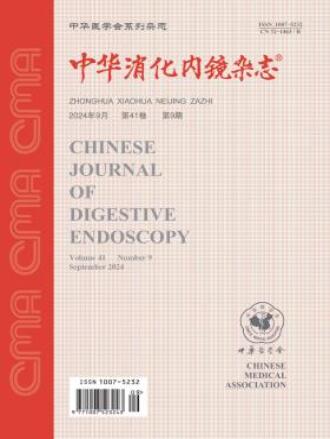内镜下经胃胆囊保留胆囊切除术治疗胆囊结石的初步研究(附视频)
引用次数: 1
摘要
目的探讨内镜下经胃胆囊保留胆囊切除术(ETGC)治疗胆囊结石的可行性和安全性。方法回顾性分析2017年3月至2019年5月在中山医院内镜中心接受ETGC治疗的84例胆囊结石患者的临床资料。总结结石的手术完成率、手术时间、并发症及复发情况。结果84例胆囊结石中,单结石19例(22.6%),多结石53例(63.1%),胆囊结石合并胆囊息肉12例(14.3%)。共有82名患者(97.6%)成功完成了ETGC,中位手术时间为88分钟。10名患者(12.2%)术后出现腹痛,其中6名患者在保守治疗后缓解。其他4例,包括2例腹腔积血、1例胆瘘和1例胆总管结石伴梗阻性黄疸,经相应干预后均痊愈。截至2019年6月14日,5例失访(随访率93.9%,77/82)。残余结石2例(2.6%,2/77)。结石复发4例(5.2%,4/7),胆囊胆固醇结晶2例(2.6%,2/77)。结论ETGC治疗胆囊结石微创、可行、安全,可保留胆囊功能。然而,ETGC如何彻底清除结石并避免残留仍需进一步探索,其长期疗效仍需进一步观察。关键词:胆囊结石;内镜下经胃胆囊结石切开术;石渣;结石复发本文章由计算机程序翻译,如有差异,请以英文原文为准。
A preliminary study of endoscopic trans-gastric gallbladder-preserving cholecystolithotomy for cholecystolithiasis (with video)
Objective
To investigate the feasibility and safety of endoscopic trans-gastric gallbladder-preserving cholecystolithotomy (ETGC) for gallstones.
Methods
The clinical data of 84 cholecystolithiasis patients, who received ETGC at Endoscopic Center of Zhongshan Hospital from March 2017 to May 2019 were analyzed retrospectively. The operation completion rate, operation time, complications and recurrence of calculus were summarized.
Results
In the 84 cases of cholecystolithiasis, there were 19 cases (22.6%) of single stone, 53 cases (63.1%) of multiple stones, and 12 cases (14.3%) of gallstones with gallbladder polyps. A total of 82 patients (97.6%) successfully completed ETGC with median operation time of 88 min. Ten patients (12.2%) suffered from abdominal pain after operation, of which 6 patients relieved after conservative treatments. The other 4 cases, including 2 cases of hemoperitoneum, 1 case of biliary fistula, and 1 case of choledocholithiasis with obstructive jaundice, were recovered after corresponding interventions. As of June 14, 2019, 5 cases were lost to follow-up (follow-up rate was 93.9%, 77/82). Residual stones were found in 2 cases (2.6%, 2/77). Stone recurrence was discovered in 4 cases (5.2%, 4/7), and 2 cases (2.6%, 2/77) had cholesterol crystallization in gallbladder.
Conclusion
ETGC is minimally invasive, feasible and safe in treatment of cholecystolithiasis, and can retain the function of gallbladder. However, how to completely remove the stones and avoid residue by ETGC still needs further exploration, and its long-term efficacy still needs further observation.
Key words:
Cholecystolithiasis; Endoscopic trans-gastric cholecystolithotomy; Stone residue; Stone recurrence
求助全文
通过发布文献求助,成功后即可免费获取论文全文。
去求助
来源期刊
CiteScore
0.10
自引率
0.00%
发文量
7555
期刊介绍:
Chinese Journal of Digestive Endoscopy is a high-level medical academic journal specializing in digestive endoscopy, which was renamed Chinese Journal of Digestive Endoscopy in August 1996 from Endoscopy.
Chinese Journal of Digestive Endoscopy mainly reports the leading scientific research results of esophagoscopy, gastroscopy, duodenoscopy, choledochoscopy, laparoscopy, colorectoscopy, small enteroscopy, sigmoidoscopy, etc. and the progress of their equipments and technologies at home and abroad, as well as the clinical diagnosis and treatment experience.
The main columns are: treatises, abstracts of treatises, clinical reports, technical exchanges, special case reports and endoscopic complications.
The target readers are digestive system diseases and digestive endoscopy workers who are engaged in medical treatment, teaching and scientific research.
Chinese Journal of Digestive Endoscopy has been indexed by ISTIC, PKU, CSAD, WPRIM.

 求助内容:
求助内容: 应助结果提醒方式:
应助结果提醒方式:


